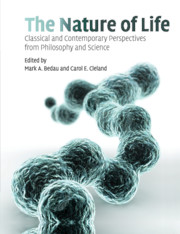Book contents
- Frontmatter
- Contents
- Preface
- Acknowledgments
- Sources
- About the authors
- Introduction
- SECTION I CLASSICAL DISCUSSIONS OF LIFE
- 1 De Anima (selections)
- 2 Treatise on Man
- 3 Critique of the teleological power of judgment (selections)
- 4 What is Life? (selections)
- 5 The nature of life
- 6 What is the meaning of “life”?
- 7 The principles of life (selections)
- SECTION II THE ORIGIN AND EXTENT OF NATURAL LIFE
- SECTION III ARTIFICIAL LIFE AND SYNTHETIC BIOLOGY
- SECTION IV DEFINING AND EXPLAINING LIFE
- Supplementary bibliography on life
- Index
2 - Treatise on Man
Published online by Cambridge University Press: 10 November 2010
- Frontmatter
- Contents
- Preface
- Acknowledgments
- Sources
- About the authors
- Introduction
- SECTION I CLASSICAL DISCUSSIONS OF LIFE
- 1 De Anima (selections)
- 2 Treatise on Man
- 3 Critique of the teleological power of judgment (selections)
- 4 What is Life? (selections)
- 5 The nature of life
- 6 What is the meaning of “life”?
- 7 The principles of life (selections)
- SECTION II THE ORIGIN AND EXTENT OF NATURAL LIFE
- SECTION III ARTIFICIAL LIFE AND SYNTHETIC BIOLOGY
- SECTION IV DEFINING AND EXPLAINING LIFE
- Supplementary bibliography on life
- Index
Summary
These men will be composed, as we are, of a soul and a body. First I must describe the body on its own; then the soul, again on its own; and fìnally I must show how these two natures would have to be joined and united in order to constitute men who resemble us.
I suppose the body to be nothing but a statue or machine made of earth, which God forms with the explicit intention of making it as much is possible like us. Thus God not only gives it externally the colours and shapes of all the parts of our bodies, but also places inside it all the parts required to make it walk, eat, breathe, and indeed to imitate all those of our functions which can be imagined to proceed from matter and to depend solely on the disposition of our organs.
We see clocks, artificial fountains, mills, and other such machines which, although only man-made, have the power to move of their own accord in many different ways. But I am supposing this machine to be made by the hands of God, and so I think you may reasonably think it capable of a greater variety of movements than I could possibly imagine in it, and of exhibiting more artistry than I could possibly ascribe to it.
Now I shall not pause to describe the bones, nerves, muscles, veins, arteries, stomach, liver, spleen, heart, brain, or any of the various other parts from which this machine must be composed.
- Type
- Chapter
- Information
- The Nature of LifeClassical and Contemporary Perspectives from Philosophy and Science, pp. 15 - 20Publisher: Cambridge University PressPrint publication year: 2010
- 3
- Cited by

